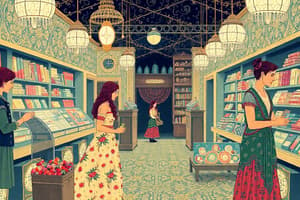Podcast
Questions and Answers
Qué ocurre en la primera etapa del proceso de búsqueda de información?
Qué ocurre en la primera etapa del proceso de búsqueda de información?
- Se clasifica la información en función del precio.
- Se identifican las necesidades del consumidor.
- Se realiza una búsqueda pasiva en la memoria. (correct)
- Comienza la búsqueda activa en fuentes externas.
Cuál es el objetivo principal de la etapa de intención de compra?
Cuál es el objetivo principal de la etapa de intención de compra?
- Buscar información en otras fuentes.
- Evaluar las alternativas de consumo.
- Identificar la satisfacción del cliente después de la compra.
- Facilitar el proceso de compra al consumidor. (correct)
Qué aspecto es crítico en la etapa de post compra?
Qué aspecto es crítico en la etapa de post compra?
- Los clientes ya no evalúan su satisfacción.
- Los consumidores evalúan si sus expectativas fueron satisfechas. (correct)
- Las empresas deben proporcionar información previa a la compra.
- Las empresas deben ignorar la retroalimentación del cliente.
Qué factores se consideran al jerarquizar la información en la identificación de alternativas?
Qué factores se consideran al jerarquizar la información en la identificación de alternativas?
Qué tipo de búsqueda de información se realiza en la segunda etapa?
Qué tipo de búsqueda de información se realiza en la segunda etapa?
¿Quién en el proceso de compra tiene la responsabilidad de autorizar la compra de un producto?
¿Quién en el proceso de compra tiene la responsabilidad de autorizar la compra de un producto?
¿Qué rol tiene el veterinario en el proceso de decisión de compra del alimento para perros?
¿Qué rol tiene el veterinario en el proceso de decisión de compra del alimento para perros?
En la teoría del comportamiento del consumidor, ¿qué propone la teoría psicoanalítica?
En la teoría del comportamiento del consumidor, ¿qué propone la teoría psicoanalítica?
¿Cuál es el primer paso en el proceso de decisión de compra?
¿Cuál es el primer paso en el proceso de decisión de compra?
En el ejemplo proporcionado, ¿quién es el usuario del alimento para perros?
En el ejemplo proporcionado, ¿quién es el usuario del alimento para perros?
¿Qué tipo de conducta podemos observar después de la compra según el proceso de decisión?
¿Qué tipo de conducta podemos observar después de la compra según el proceso de decisión?
La teoría del aprendizaje sugiere que el comportamiento del consumidor cambia después de:
La teoría del aprendizaje sugiere que el comportamiento del consumidor cambia después de:
¿Qué acción se considera como un desequilibrio entre el estado real y el estado deseado en el proceso de decisión de compra?
¿Qué acción se considera como un desequilibrio entre el estado real y el estado deseado en el proceso de decisión de compra?
¿Cuál de las siguientes opciones representa mejor un cliente en el contexto de una tienda de ropa?
¿Cuál de las siguientes opciones representa mejor un cliente en el contexto de una tienda de ropa?
¿Cuál de los siguientes factores no se menciona como influyente en la conducta del consumidor?
¿Cuál de los siguientes factores no se menciona como influyente en la conducta del consumidor?
¿Cómo se define el comportamiento del consumidor en relación a los bienes y servicios?
¿Cómo se define el comportamiento del consumidor en relación a los bienes y servicios?
En la compra de un producto, ¿cuál de los siguientes aspectos es importante considerar según la motivación del consumidor?
En la compra de un producto, ¿cuál de los siguientes aspectos es importante considerar según la motivación del consumidor?
¿Cuál de las siguientes afirmaciones es verdadera sobre el consumidor y el cliente?
¿Cuál de las siguientes afirmaciones es verdadera sobre el consumidor y el cliente?
¿Cuál es un ejemplo de una variable que influye en el comportamiento del consumidor?
¿Cuál es un ejemplo de una variable que influye en el comportamiento del consumidor?
¿Qué implica el proceso de decisión de compra del consumidor?
¿Qué implica el proceso de decisión de compra del consumidor?
¿Qué se entiende por 'percepción' en el contexto de la conducta del consumidor?
¿Qué se entiende por 'percepción' en el contexto de la conducta del consumidor?
Flashcards
Consumer Behavior
Consumer Behavior
The internal or external attitude of individuals or groups aimed at satisfying their needs through goods and/or services.
Customer
Customer
A person who periodically or occasionally buys from a store or company; may or may not be the end-user. They purchase the product for its benefit.
Consumer
Consumer
The person who actually uses the product or service for its benefit.
Buying Process
Buying Process
Signup and view all the flashcards
Motivation in Consumer Behavior
Motivation in Consumer Behavior
Signup and view all the flashcards
Perception in Consumer Behavior
Perception in Consumer Behavior
Signup and view all the flashcards
Personality in Consumer Behavior
Personality in Consumer Behavior
Signup and view all the flashcards
Learning in Consumer Behavior
Learning in Consumer Behavior
Signup and view all the flashcards
Information Search
Information Search
Signup and view all the flashcards
Evaluation of Alternatives
Evaluation of Alternatives
Signup and view all the flashcards
Purchase Intention
Purchase Intention
Signup and view all the flashcards
Post-Purchase Evaluation
Post-Purchase Evaluation
Signup and view all the flashcards
Active vs. Passive Information Search
Active vs. Passive Information Search
Signup and view all the flashcards
Consumer Roles
Consumer Roles
Signup and view all the flashcards
Consumer Buying Process
Consumer Buying Process
Signup and view all the flashcards
Initiator
Initiator
Signup and view all the flashcards
Influencer
Influencer
Signup and view all the flashcards
Decider
Decider
Signup and view all the flashcards
Economic Theory (consumer)
Economic Theory (consumer)
Signup and view all the flashcards
Need Recognition
Need Recognition
Signup and view all the flashcards
Post-purchase evaluation
Post-purchase evaluation
Signup and view all the flashcards
Study Notes
Apunte Docente - Semana 10
-
Conducta del Consumidor: Understanding consumer behavior involves examining the differences between simple and complex purchases (e.g., a candy bar vs. a phone). Consumer preferences often favor specific brands, raising questions about brand differentiation.
-
Factores en la Compra: Consumer purchasing processes should consider fundamental human aspects such as motivations, perception, personality, learning, and cultural influences.
-
Comportamiento del Consumidor: Defined as internal and external actions of individuals or groups aimed at satisfying needs through goods, services, or ideas. This process includes decision-making and purchasing activities.
-
¿Quiénes son los clientes de una empresa?: A client is anyone who makes a purchase, whether or not they are the end-user. Clients may or may not be the final consumers. Examples demonstrate how clients and consumers can be different people.
-
Tipos de Clientes:
- Iniciador: Identifies a need.
- Influenciador: Influences the buying decision.
- Decisor: Makes the final decision on purchase.
- Comprador: Handles the actual purchase procedure.
- Usuario: Person who uses the product.
-
Teorías del Comportamiento del Consumidor:
- Teoría Económica: Consumers prioritize achieving the best value for their money.
- Teoría Psicoanalítica: Consumer behavior is driven by internal forces like desires and anxieties (beyond just rational economic choices).
- Teoría del Aprendizaje: Past experiences and learning influence current buying decisions.
- Teoría Social: Social influences impact consumer behavior, often through copying the behavior of social groups.
-
Proceso de Decisión de Compra:
- Reconocimiento del problema o necesidad: Recognising a need or want.
- Búsqueda de información: Gathering information about possible solutions.
- Identificación y evaluación de alternativas: Comparing potential solutions based on factors like price, quality, and other concerns.
- Decisión de compra: Making the purchase decision.
- Conducta posterior a la compra: Evaluation following the purchase.
-
Reconocimiento del Problema o Necesidad: Consumer behavior starts with identifying a gap between current state and desired state. This often occurs when an existing need is not satisfied, or a new need emerges. External stimuli can also trigger needs.
-
Busqueda de Información: Consumers initially rely on passive information retrieval (internal search) from memory to identify product alternatives. Active information-seeking (external search) may involve consulting diverse sources, e.g., news, internet, recommendations.
-
Identificación y Evaluación de Alternativas: Consumers actively evaluate possible alternatives based on factors like price, quality, and location.
-
Compra: This is when the purchase takes place.
-
Post Compra: This includes evaluations of satisfaction after the purchase. Companies should be prepared to address customer concerns post-purchase.
Studying That Suits You
Use AI to generate personalized quizzes and flashcards to suit your learning preferences.
Related Documents
Description
Este cuestionario explora el comportamiento del consumidor, abarcando las diferencias entre compras simples y complejas. Se analizarán factores que influyen en el proceso de compra, así como la definición de clientes y tipos de clientes. Ideal para estudiantes que buscan comprender los fundamentos del marketing y la conducta del consumidor.




